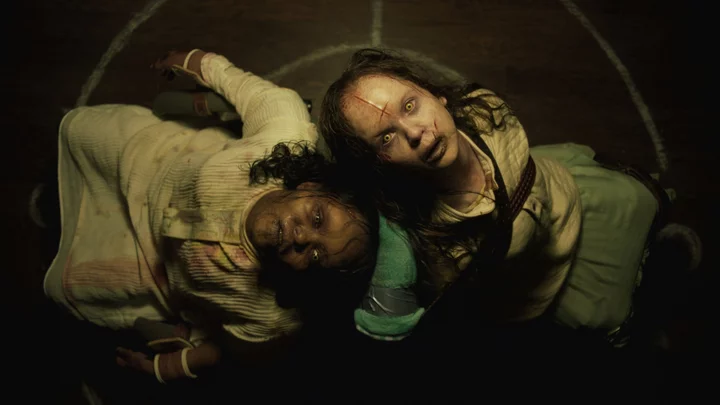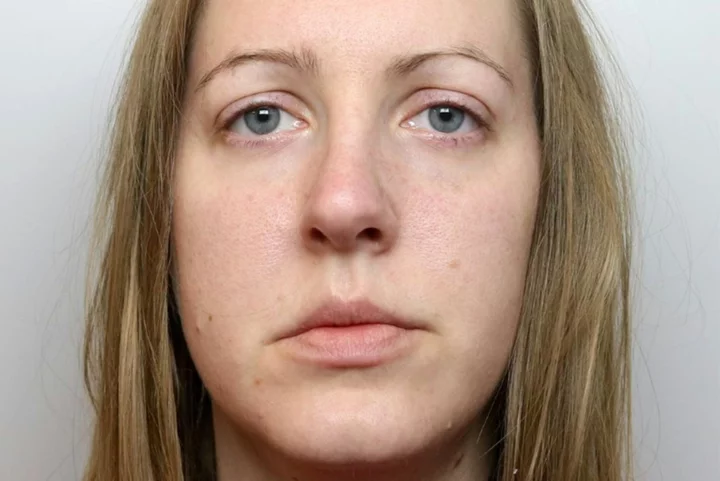What's better than one possessed child? Two possessed children! At least, that's what The Exorcist: Believer seems to think. Yet as this misguided sequel plays out, it quickly becomes clear that when it comes to demonic kiddos, less is far, far better than more.
This overstuffed yet under-developed entry into the Exorcist series is the latest in a slew of legacy sequels to classic horror franchises, including Scream, The Texas Chainsaw Massacre, and Halloween. It even has a legacy sequel pro at the head, with recent Halloween trilogy director David Gordon Green taking the reins. But as an unquestionably iconic horror classic, The Exorcist is a tough act to follow. The Exorcist: Believer fails to capture even an ounce of the terror and emotional heft of the late William Friedkin's original.
SEE ALSO: Everything you need to know before seeing 'The Exorcist: Believer'What's The Exorcist: Believer about?
Lydia Jewett and Olivia O'Neill in "The Exorcist: Believer." Credit: Universal PicturesThe Exorcist introduced us to the loving family of actor Chris MacNeil (Ellen Burstyn) and her daughter Regan (Linda Blair), whose demonic possession turned her into a blasphemous, vomit-spewing hellspawn. The Exorcist: Believer introduces us to a similarly caring family unit: Victor Fielding (Leslie Odom Jr.) and his daughter Angela (Lidya Jewett).
As much as Victor and Angela love and support one another, Angela feels a need to connect to her mother Sorenne (Tracey Graves), who passed away in the 2010 Haiti earthquake. (Yes, that disaster is what the film chooses to open with.) To speak with Sorenne, Angela enlists the help of fellow teen Katherine (Olivia O'Neill) for an otherworldly ritual. Presumably, the two are friends, but you would barely know that given how little time The Exorcist: Believer spends on their relationship. Naturally, the ritual goes wrong, and the pair go missing for three days, only to turn up later with strange injuries, no memory of what happened, and a disturbing tendency to snarl profanities at their caretakers.
SEE ALSO: 33 best horror movies on Prime Video to keep you up at nightBecause you can't have a legacy sequel without appearances from the original cast, Victor seeks out the one living person who's witnessed this level of possession before: Chris MacNeil. Since the events of the first film, she's dedicated her life to teaching the world about possession and exorcism rites from various cultures — but alienated Regan in the process. Can she help Victor's family stay together where hers fell apart? And will she spearhead this film's exorcism after being sequestered from the pivotal scene in the original?
Don't get your hopes up.
The Exorcist: Believer doesn't do Chris MacNeil or The Exorcist justice.
Leslie Odom Jr. and Ellen Burstyn in "The Exorcist: Believer." Credit: Eli Joshua Adé / Universal PicturesAfter catching up with Chris, The Exorcist: Believer almost immediately sidelines her, once again excluding her from some of the film's most climactic moments. Burstyn barely gets a chance to do anything apart from discussing the book Chris wrote about Regan's possession, but even that rings false.
You're telling me Chris MacNeil, who fought tooth and nail to save her daughter from a hellish experience, would suddenly air that experience to the entire world at the expense of re-traumatizing her daughter? The Exorcist: Believer waves this concern off with some discussion of Chris wanting to help others through their trauma. But really, it comes off as an ineffective excuse to shoehorn her into the film in some way.
The disrespectful treatment of Chris is just one of many ways in which The Exorcist: Believer can't live up to Friedkin's original film. Both films play off parental fears about the unthinkable happening to your children, but only The Exorcist packs real scares. Who can forget Regan's spinning head, or the shocking image of her violently masturbating with a crucifix? The Exorcist: Believer's over-reliance on jump scares pales in comparison — as do its rehashes of The Exorcist's previously mentioned greatest hits.
SEE ALSO: 'Pet Sematary: Bloodlines' review: A truly lifeless Stephen King prequelThe most successful — and disturbing — of these rehashes doesn't even directly involve possession. Right after Angela and Katherine resurface, they're examined at a hospital. Doctors take photos of their wounds, swab their mouths, and perform a pelvic exam to search for signs of sexual trauma. While the doctors speak calmly and try to comfort the girls, there's still a sense of clinical detachment.
Tears flow down Angela's cheeks as she tries to process what's happened, while Victor is forced to stand back and consider the very real possibility of assault. The sequence calls to mind The Exorcist's graphic angiography scene, where a bloody medical procedure is documented in unsparing detail as Chris looks on. As with all things in The Exorcist: Believer, this hospital scene is a shadow of the original. Here, though, there's a deeper sense of dread at play than in any of the possession scenes.
SEE ALSO: 'Dead Ringers' review: Rachel Weisz meets David Cronenberg in tale of twisted twinsThe Exorcist: Believer proves that one possession is more effective than two.
The cast of "The Exorcist: Believer." Credit: Eli Joshua Adé / Universal PicturesThe gimmick of two simultaneous possessions wears thin as The Exorcist: Believer trudges on. The film is barely able to develop one of the girls' characters fully, let alone two. Neither possession is particularly visually distinctive, lacking any truly visceral gore or distinguishing features. For their parts, though, Jewett and O'Neill commit impressively to the physicality of their characters' plights, writhing and stretching their limbs at increasingly unnatural angles.
The Exorcist used Regan's supernatural possession as a means of examining the strain on family ties and the roles faith and theology can play during crises. In The Exorcist: Believer, these ideas are mostly split between Angela and Katherine. Victor is not a spiritual man, but he is determined to keep his promise to a dying Sorenne and protect Angela at all costs. Meanwhile, the only real characterization of Katherine and her parents (Jennifer Nettles and Norbert Leo Butz) is "God-loving Christians." So, it's they who reckon with their faith when the devil takes control of their child. Their religious views also allow The Exorcist: Believer to engage in some lackluster church scenes, where Katherine screams about the body and the blood of Christ for a bit. It's only mildly unsettling, but then again, can anything compare to Regan's bedroom battles?
To its credit, The Exorcist: Believer does attempt to look more closely at how other forms of faith beyond Catholicism may deal with demonic possession. Chris makes some vague comments about other cultures' exorcism procedures. But the approach this sequel truly dives into is Rootwork, or Hoodoo, a spiritual practice created by enslaved African Americans.
This practice is introduced in the film by Doctor Beehibe (Okwui Okpokwasili), a root doctor who Victor asks to help with Angela and Catherine's exorcism. Her inclusion makes for a nice break from the films' reliance on Christian rituals and broadens the franchise's idea of what an exorcist can be. However, in an already overcrowded film, Doctor Beehibe risks getting lost in the noise. It's a shame, as she is one of the few aspects of The Exorcist: Believer that doesn't feel like an uninspired retread.
Beyond its shallow callbacks to the original film, The Exorcist: Believer's worst sin is the simple fact that it's boring. Limited scares, underdeveloped characters, and a hackneyed message about unity will make you yearn for escape — even as the movie tees up for a sequel.
Perhaps that film could possess even an ounce of The Exorcist's power, but given the pure tedium of this attempt at a legacy sequel, I can safely say I'm a nonbeliever.









